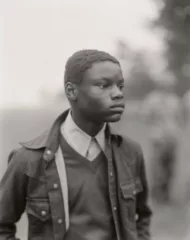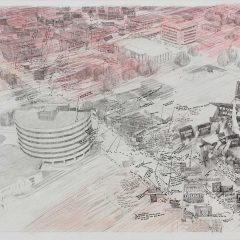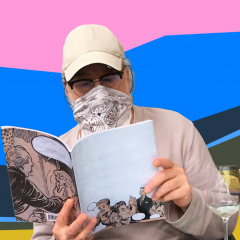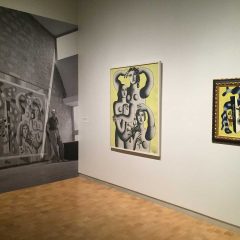The massive two-museum blast of Dynasty, an exhibition of 40 artists at the Palais de Tokyo and the Musée d’Art Moderne de la Ville de Paris, is something of a moveable feast of contemporary French art – a collision of dust and Disney with a bit of dinnertime thrown in. The concept, launched by directors Marc-Olivier Wahler and Fabrice Hergott was to invite youngish artists working in France to exhibit two sets of works in each museum. (The two art spaces sit side-by-side looking out towards the Seine River). A stereo effect was anticipated across the vast 5,000-square meters of exhibition space of the two institutions. And, I should note, a large inviting bar and café area offering cocktails and pumping hip-hop sits between the two museums – clearly the place you want to be after the art.
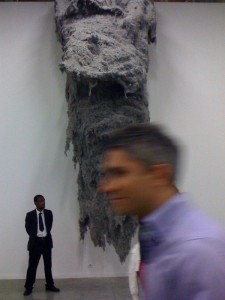
Typical of openings in Paris, one first notices the crowd – pretty young girls in party dresses, isolated young men searching for meaning (and girls), and groups of adults wandering in and around the installations trying to figure out exactly what the heck contemporary art is all about.
One installation, however, was unanticipated: Fresh white wall paint drying in the heat of of all those French bodies permeated the entire exhibition. Something of a cross between an explosion in a Home Depot paint department and an experiment on group olfactory nerves, the effect was potent (and unintended) but made me think of Yves Klein’s forceful “Le Vide” 1959, a monumental exhibition of “nothing” at Iris Clert’s gallery in Paris that showed simply the white walls of the empty space “sensitized by the artist.” (Idea: Hey! Palais de Tokyo connect with industrial air conditioner or freezer makers Carrier or Subzero to cool the place down, and offer them giant corporate logo in the entrance).
Among the artworks, however, several grabbed my attention enough to distract me from the faux Klein, even if they seemed to be ambitious remakes of other ideas that have coursed through art history.
Yuhsin U. Chang’s “Poussière dans le Palais de Tokyo” (Dust in the Palais de Tokyo), top picture, an enormous Loch Ness lint monster seemingly pouring out from a high wall, dramatized the exhibition like no other installation. Like a frozen waterfall, “Poussière” undoubtedly contained the microscopic history of any and all who have passed through the museum in the past year, a dry grey cocktail of DNA and pigeon feathers, molecular bits of car wheels, dog crap and the flotsam of the real world. I loved that the installation was marked with a card explaining: “Dimensions variable.” (Chang’s dustworks appear in both exhibition spaces.)
One should note that Man Ray famously photographed dust in a 1920 work Dust Breeding (Duchamp’s Large Glass with Dust Notes) and more recently Xu Bing used Ground Zero dust for a 2004 installation in Wales, Where Does the Dust Itself Collect? 何处若尘埃? (Bing won 40,000 pounds for his dusty piece).
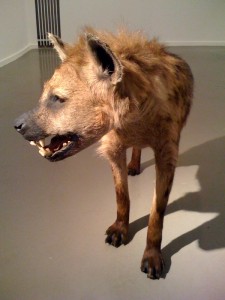
Taxidermy and dentistry also played a part in the exhibition. Nicholas Milhé’s stuffed hyena mined the continued interest in dead animals (Hirst) and cranial surgery (Hirst again). Milhé, reports the info-card glued to the wall behind “Untitled” 2009, is an expert in the “aesthetics of disruption and contextual creation.” He offers us a “sculpture” of a snarling beast quietly featuring a pair of gold molars in the hyena’s mouth. (Note bene: Price of gold as of this posting is $1247.76 an ounce and climbing!). Obviously the piece is a metaphor for the art world, the real world, artists and dealers and British Petroleum. On the Palais de Tokyo side, Milhé produced a kind of photo landscape “fortress” that reminded me of theater props; a long rectangular slit is cut into it, supposedly to shoot arrows from as in medieval times, but still clearly useful today.
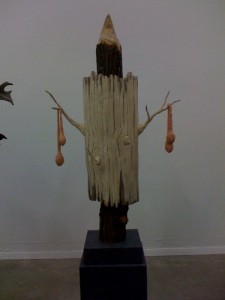
Théo Mercier’s five totems comprised of dirt, skin, glass, wood and skin are minor gods the artist portends are deformed, decadent and borderline. And hey, they are fun for the family, too, in a weird Disney kind of way. On one – a tree stump, two pairs of testicles hang over the two branches. You could hardly tell they were composed of anything other than Disneyland dust and (probably drugs). His “Green with Anger” 2010, smiles from multiple pairs of teeth (yes, more teeth) from a vegetable green mass of face. Across the way in the Musée de la Ville de Paris, Mercier’s “Le Solitaire” 2010, is another giant – this one nearly 10 feet tall sculpted from spaghetti. The press on Mercier is that his work concerns waiting and sadness. Sounds like the 21st century to me.
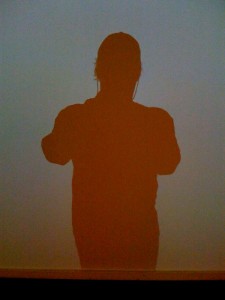
The French pair, Fabien Giraud and Raphaël Siboni, produced a pair of slow moving videos that hogged two entire walls in each exhibition space. I was too slow myself to discern, in the video “Untitled” 2009, the setting sun made without a lens. The other large-scale video is a pattern of light derived from a computation that theoretically chugs along for a billion plus years crunching out a “zero equation whose outcome can only be zero.” I stood in front of one of these giants and took a photograph of my shadow. At first, I thought that was, in fact the point. (Everyone has cell phone cameras). But in fact the point was zero.
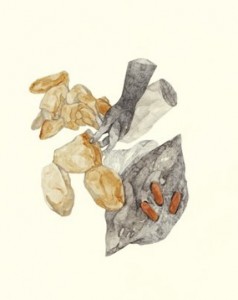
While painting was represented, like Raphaëlle Ricol’s large-scale canvases of heads exploding in graffiti, it seemed oddly old-fashioned, a relic from the 20th century. Small delicate drawings by Melanie Delattre-Vogt, showing how to stuff a chicken after you’ve defrosted it (that is indeed the title), issue from a French encyclopedia on the subject. The 21 drawings are elegant and muted in ochre and gray and sienna and arranged in a line; a sound track from the source book quietly explains the stuffing process. And, I should note, the French fascination with frozen foods: A Picard frozen food store, a chilly laboratory of iced boxes of lobsters, chicken and vegetables, dots nearly every neighborhood in Paris. Dinner remains serious business in France.
If the twin showings showed me anything it was that there is an enormous amount of art being produced in France, a phenomenon reproduced mostly everywhere these days. And while the work itself is not easy (or even possible) to grasp, whether the pieces are large architectural structures or cartoon dieties or even dust, the show draws in ever larger crowds to figure it all out or just inhale the fresh paint.
While my take is subjective and a small slice of the exhibition, do take some time to view all the artists in the exhibition here: DYNASTY.
Info: Dynasty at the Palais de Tokyo and the Musée d’Art Moderne de la Ville de Paris, from June 11 – September 5, 2010. 13 Avenue du Président Wilson
75016 Paris, France.


